This article needs additional citations for verification .(December 2014) |
The military reserve forces of France are the military reserve force within the French Armed Forces.
This article needs additional citations for verification .(December 2014) |
The military reserve forces of France are the military reserve force within the French Armed Forces.
From the very moment Napoléon Bonaparte took power as First Consul in the coup of 18 Brumaire, he was feared by his rivals, and keenly supported by the army. They participated in the creation of a new constitution that forbade a Consul from leading an active army outside France. The violence of the coup d'état had already caused disquiet, and the consuls had access to an impressive Consular Guard.[ citation needed ]
Following the new constitution to the letter, Napoléon raised a reserve army (and thus not counting as an active army) at Dijon to support his war effort in Italy. This was the turning point of his Second Italian campaign. [1]
From 1866, Napoleon III wanted to establish a military reserve comparable to the Prussian Landwehr. The army reserve was created by law on 27 July 1872 following the disbandment of the National Guard. [2] [3]
This law established a military service obligation of twenty years for French men as follows:
Not every man served five years as the duration of active service was drawn by lots, with some only serving one year whilst others served the full five years.
On 25 July 1889, military service was increased to twenty-five years; with three years in the active army, seven years in the Army Reserve, six years in the Territorial Army, and nine years in the Territorial Army Reserve. The law required members of the Army Reserve to participate in two exercises of four weeks each, and members of the Territorial Army to one exercise of two weeks. [5]
On 21 March 1905, the drawing of lots was abolished. The increase in conscripts allowed service in the active army to be reduced to two years whilst still maintaining its strength. And members of the Territorial Army Reserve had to participate in one exercise of nine days. [6]
On 7 Aug 1913, service in the active army was restored to three years, and the conscription age was lowered to 20. Military service was increased to twenty-eight years by extending service in the Army Reserve to eleven years. [7]
On mobilisation in 1914, the active army was supplemented by:
The Territorial Army Reserve was expanded to include men aged from 46 to 49, i.e. born between 1865 and 1868.
On the suspension of obligatory national service and the professionalisation of its armies, France also modified the organisation of its military reserve in the same professionalising way. Law n°99-894 of 22 October 1999 (modified by law 2006-449 of 18 April 2006) set out the organisation of the military reserve and of the defence forces.
The military reserve was organised into two bodies :
These reservists serve in many branches of the forces - the air force, army, gendarmerie, navy, health service, supply corps, and DGA.
The Army operational reserve is about 60% headquarters/staff specialists and 40% sub-unit reservists (company, battery, squadron, drill).
Two types of reserve units are in service:
Training consists of:
Among the units expected to form reserve sub-units, circa 2014, were the 1st Infantry Regiment at Sarrebourg; the 35th Infantry Regiment at Belfort; the 92nd Infantry Regiment at Clermont-Ferrand; the 126th Infantry Regiment (Brive); 152nd Infantry Regiment (Colmar); fr:7e bataillon de chasseurs alpins (7e BCA) at Varces ; 13e BCA at Barby; 16e BC at Bitche; 27e BCA ; Annecy; 1er RTir ; Epinal; 1er RCP at Pamiers; 501e RCC at Mourmelon Le Grand; 1er RCh at Thierville Sur Meuse; 4e RCh ; Gap; 12e RC ; Olivet; 4e RD ; Carnoux En Provence; 1er RHP ; Tarbes; 3e RH at Metz; and the 1st Spahi Regiment (1er RS) at Valence.
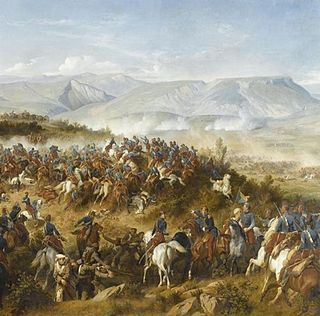
The Chasseurs d'Afrique were a light cavalry corps of chasseurs in the French Armée d'Afrique. First raised in 1831 from regular French cavalry posted to Algeria, they numbered five regiments by World War II. For most of their history they were recruited from either French volunteers or French settlers in North Africa doing their military service. As such they were the mounted equivalent of the French Zouave infantry. The other major cavalry element in the Armee d'Afrique were the Spahis—recruited from the indigenous peoples of Algeria, Tunisia, and Morocco with mostly French officers.

Philippe François Marie Leclerc de Hauteclocque was a Free-French general during the Second World War. He became Marshal of France posthumously in 1952, and is known in France simply as le maréchal Leclerc or just Leclerc.
The 1st Foreign Engineer Regiment is one of two combat engineer regiments of the Foreign Legion in the French Army. The regiment provides the combat engineering component of the 6th Light Armoured Brigade.
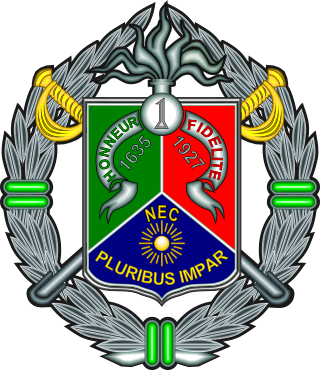
The 1st Foreign Cavalry Regiment is the only cavalry regiment of the Foreign Legion in the French Army. It is one of two armoured cavalry regiments of the 6th Light Armoured Brigade.
The structure of the French Army is fixed by Chapter 2 of Title II of Book II of the Third Part of the Code of Defense, notably resulting in the codification of Decree 2000-559 of 21 June 2000.
The 19th Army Corps was a corps of the French army. In December 1870, the Tours delegation created the 19th Army Corps which was formed in Alençon. It was recreated by decree of the JO of August 13, 1874, it brought together the various military units of Algeria. It constituted the nucleus of the Army of Africa.
The Armée d'Orient (AO) was a field army of the French Army during World War I who fought on the Macedonian front.

The 1st Spahi Regiment is an armored regiment of the modern French Army, previously called the 1st Moroccan Spahi Regiment. It was established in 1914 as a mounted cavalry unit recruited primarily from indigenous Moroccan horsemen. The regiment saw service in the First World War, and in the Second World War as part of the Forces Françaises Libres, as well as post-war service in the French-Indochina War and elsewhere. The modern regiment continues the traditions of all former Spahi regiments in the French Army of Africa.

The 11th Marine Artillery Regiment (France) (French: 11e Régiment d'Artillerie de Marine, 11e RAMa) is an artillery regiment of the French Army. The regiment constitutes the fire support unit of the 9th Marine Infantry Brigade. The regiment employs around 950 men, fielding TRF1 155mm howitzers and MO-120-RT-61 120mm mortars. The regiment was founded in a third operational phase in 1951.

The following is a hierarchical outline for the French Land Army at the end of the Cold War. It is intended to convey the connections and relationships between units and formations. The theoretical combat strength of the army was 295,989 soldiers, of the 557,904 individuals available for service across the entire French Armed Forces in 1989.

Jean Victor Charles Edmond Leune was a French war correspondent, writer, press photographer, military aviator and member of the French Resistance.
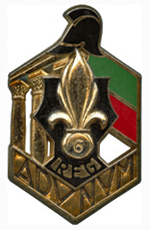
The 6th Foreign Engineer Regiment was a unit of the Foreign Legion in the French Army, part of the rapid reaction force and component of the 6th Light Armoured Division,. The 6th Foreign Engineer Regiment became the 1st Foreign Engineer Regiment in 1999.

Christian Piquemal, is a retired army corps general of the French Army and Commandant of the Legion from 1994 to 1999.
The Moroccan Division or the 1st Moroccan Division of 1914, initially the Marching Division of Morocco was an infantry division of France's Army of Africa which participated in World War I.

The 2nd Parachute Chasseur Regiment or 2e RCP, is one of the most decorated French units of the Second World War, the only land unit awarded the red fourragère in that war, including six citations at the orders of the armed forces. The French Navy 1500-ton class submarine Casabianca also accumulated six citations at the orders of the armed forces and therefore its crewmen were entitled to wear the same fourragère.
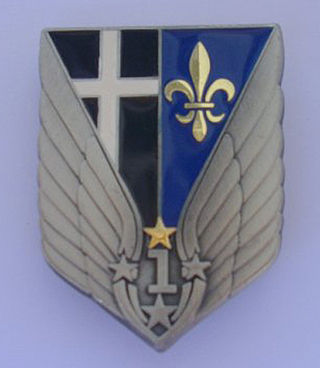
The 1st Combat Helicopter Regiment is based at Quartier La Horie, in Phalsbourg.

The Armistice Army or Vichy French Army was the armed forces of Vichy France permitted under the terms of the Armistice of 22 June 1940. It was officially disbanded in 1942 after the German invasion of the "Free Zone" which was directly ruled by the Vichy regime.
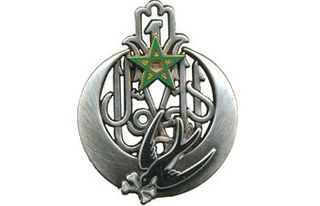
The 1st Tirailleur Regiment is a mechanized infantry unit of the French Army, created in 1994 under the command of the 7th Armoured Brigade. It is mainly composed of active soldiers but also reservists, deployed both overseas and in internal security tasks such as Operation Vigipirate. It is currently only tirailleur regiment in the French army.
Jean-François-Madeleine de Gentil was a French officer who participated to the French conquest of Algeria.
The French Territorial Army was a component of the French Army from 1872 to 1918. It comprised of men aged from 34 to 49 who were considered too old and insufficiently trained to serve in an active or reserve regiment.